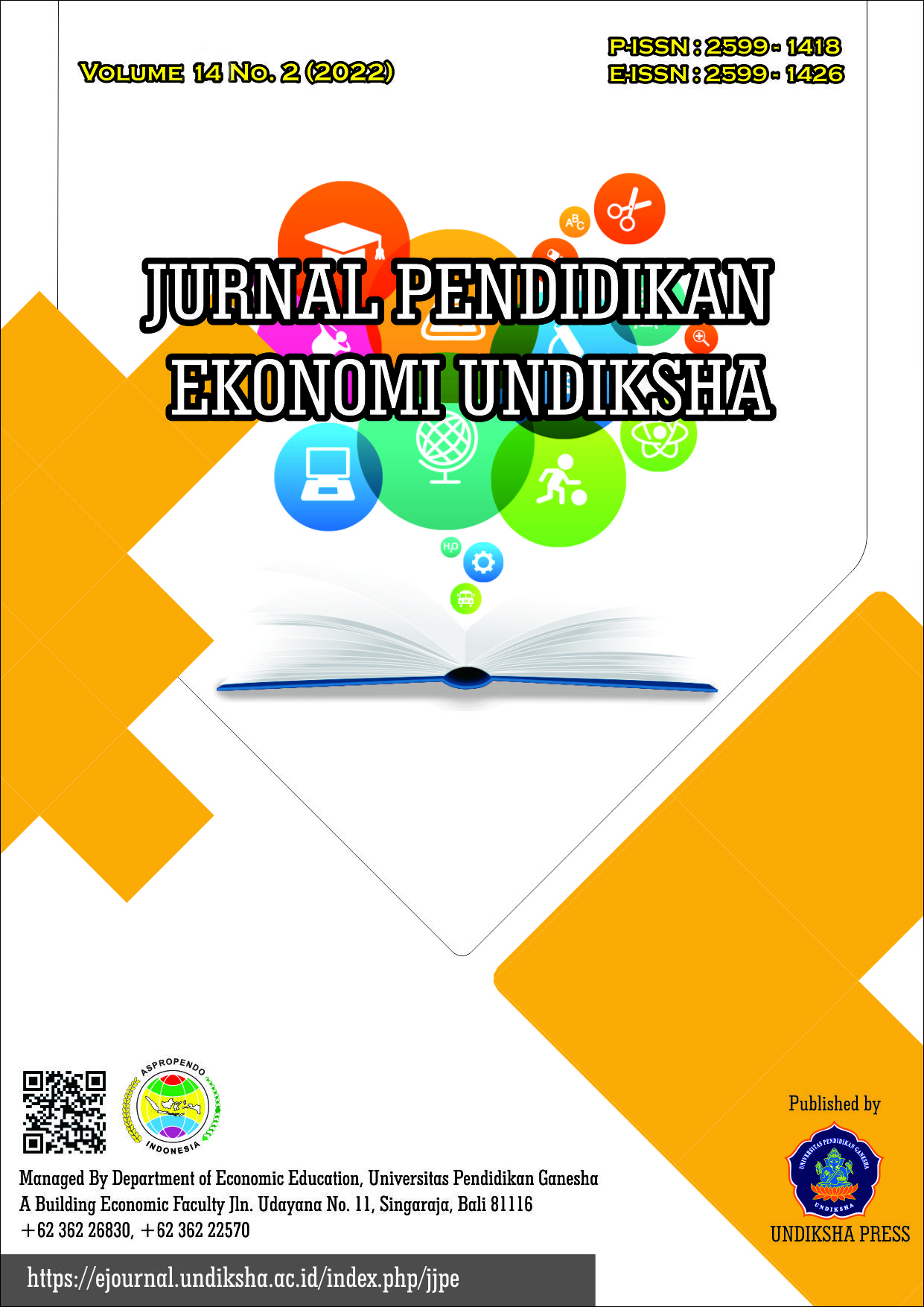Pengembangan Media Pembelajaran E-Comic Peluang Usaha Produk Barang atau Jasa Untuk Meningkatkan Hasil Belajar Peserta Didik Sekolah Menengah Kejuruan
DOI:
https://doi.org/10.23887/jjpe.v14i2.53389Kata Kunci:
Learning Media, E-Comic, Business opportunitiesAbstrak
The background that underlies the research here is the low understanding of students' learning in the subjects of Creative Projects and Entrepreneurship which causes learning outcomes to not reach classical completeness. The purpose of this development research is to describe: 1) the feasibility from E-comic of Business Opportunity learning media; 2) the practicality from E-Comic Business Opportunity learning media; and 3) the effectiveness from E-comic of Business Opportunity learning media. This research is a type of research and development (R&D) using a 4-D model. The results of this study are learning media products in the form of e-comic on the material of Business Opportunities for Goods or Services in the form of an Android-based application developed with the help of Unity software. The media developed by the researcher was tested in a limited way on students of SMK Negeri 12 Surabaya in class XI Logam 1 as the experimental class and class XI Logam 2 as the control class. Validation from experts, this e-comic obtained 89% results by material experts, 93% by media experts, and 91% by design experts so that the learning media was declared very feasible. The practicality of learning media based on the assessment of students obtained a percentage of 91% with a very practical category. The analysis of the effectiveness test from E-Comic Business Opportunity learning media obtained the results that the learning media was effective in improving student learning outcomes where when the t-test was carried out, namely the Independent Sample T-Test, there was a significant difference between the posttest of the experimental class and the control class, which was indicated by Tcount > Ttable, namely 3.438 > 2,024 and the significance value obtained is 0.001 < 0.05, besides that the average pretest value of the experimental class is 64.75 and the posttest value is 80.50 while in the control class the average pretest is 65.50 and the posttest value is 70.00 , so that the N-Gain Test obtained a Gain Score in the experimental class of 0.4 so that the increase in learning outcomes was achieved, while in the control class it was 0.1 where the increase in learning outcomes had not been achieved.
Referensi
Adeliyanti, S., Suharto, & Hobri. (2018). Pengembangan E-Comic Matematika Berbasis Teknologi Sebagai Suplemen Pembelajaran Pada Aplikasi Fungsi Kuadrat. Kadikma, 9(April), 124–129.
Aisyah, E. N., Tegaryani, S., Samawi, A., & Pramono. (2019). Entrepreneurship Berbasis Model Meaningful Intructional Design. Bandung: PT Refika Aditama.
Arikunto, S. (2013). Dasar-Dasar Evaluasi Pendidikan Edisi 2. Jakarta: PT Bumi Aksara.
Arsyad, A. (2017). Media Pembelajaran. Jakarta: Rajawali Pers.
Chuang, Y.-T. (2014). Increasing Learning Motivation and Student Engagement through the Technology- Supported Learning Environment. Creative Education, 05(23), 1969–1978. https://doi.org/10.4236/ce.2014.523221
Fradani, A. C., & Astuti, R. P. F. (2020). Pengembangan Media Pembelajaran Kewirausahaan Berbasis Komik Untuk Siswa di SMK
Negeri 1 Bojonegoro. Jurnal Ekonomi Pendidikan Dan Kewirausahaan, 8(2), 111. https://doi.org/10.26740/jepk.v8n2.p111-120
Gumilang, M. R., & Indarini, E. (2019). Pengembangan Media Komik dengan Model Problem Posing untuk Meningkatkan Kemampuan Pemecahan Masalah Matematika, 3(2), 185–196.
Irawan, A., & Hakim, M. A. R. (2021). Kepraktisan Media Pembelajaran Komik Matematika pada Materi Himpunan Kelas VII SMP/MTs. Pythagoras, 10(April), 91–100. Diambil dari https://www.journal.unrika.ac.id/index.php/jurnalphythagoras/article/view/2934
Kalvadema, R. (2017). Pengembangan Media Pembelajaran Komik Kontekstual Pada Materi Virus Untuk. Pendidikan Biologi FKIP Universitas Jambi, 1–10.
Mujahadah, I., Alman, A., & Triono, M. (2021). Pengembangan Media Pembelajaran Komik untuk Meningkatkan Hasil dan Minat Belajar Matematika Peserta Didik Kelas III SD Muhammadiyah Malawili. Jurnal Papeda: Jurnal Publikasi Pendidikan Dasar, 3(1), 8–15. https://doi.org/10.36232/jurnalpendidikandasar.v3i1.758
Rasiman, & Pramasdyahsari, A. S. (2014). Development of Mathematics Learning Media E-Comic Based on Flip Maker to Increase the Critical Thinking Skill and Character of Junior High School Student, 2(11), 535–544.
Rokhmani, L. (2016). JPE-Volume 9, Nomor 1, 2016. Pengembangan E-Comic Sebagai Media Pembelajaran; Ekonomi Kelas X dI SMAN 7 MALANG, 9, 31–40.
Sadiman, A. S. (2014). Media Pendidikan. Jakarta: Rajawali Pers.
Sugiyono. (2018). Metode Penelitian Kuantitatif, Kualitatif, dan R&D. Bandung: Alfabeta.
Suprijono, A. (2019). Cooperative Learning Teori & Aplikasi Paikem. Yogyakarta: Pustaka Pelajar.
Trianto. (2007). Model Pembelajaran Terpadu dalam Teori dan Praktek. Jakarta: Prestasi Pustaka.
Wulandari, P., W.H, E. H., & Nurwahyunani, A. (2018). Efektifitas Pembelajaran Transpor Membran Bermuatan Etnosains Terhadap Hasil Belajar Kognitif Dan Minat Berwirausaha Pada Siswa Sma. Bioma : Jurnal Ilmiah Biologi, 7(1), 53–64. https://doi.org/10.26877/bioma.v7i1.2537
Yusiana, U., & Prasetya, S. P. (2022). Pengembangan Media E-Comic terhadap Hasil Belajar Peserta Didik dalam Pembelajaran IPS. Dialektika Pendidikan IPS, 1(1), 23–33.
Unduhan
Diterbitkan
Terbitan
Bagian
Lisensi
Hak Cipta (c) 2022 Jurnal Pendidikan Ekonomi Undiksha

Artikel ini berlisensiCreative Commons Attribution-ShareAlike 4.0 International License.





